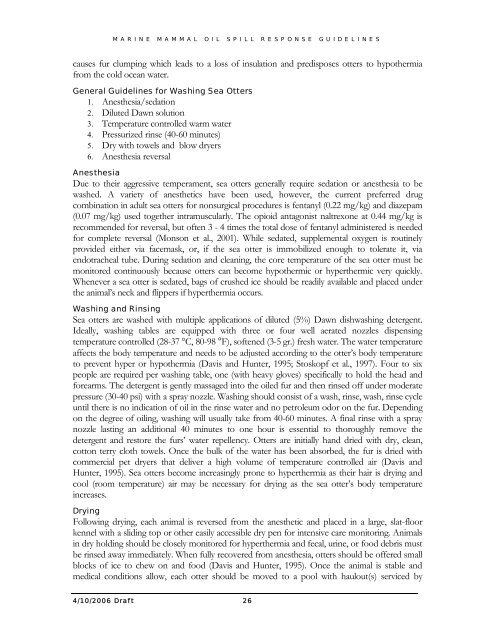Volume III, Appendices EM - National Marine Fisheries Service ...
Volume III, Appendices EM - National Marine Fisheries Service ...
Volume III, Appendices EM - National Marine Fisheries Service ...
You also want an ePaper? Increase the reach of your titles
YUMPU automatically turns print PDFs into web optimized ePapers that Google loves.
MARINE MAMMAL OIL SPILL RESPONSE GUIDELINES<br />
causes fur clumping which leads to a loss of insulation and predisposes otters to hypothermia<br />
from the cold ocean water.<br />
General Guidelines for Washing Sea Otters<br />
1. Anesthesia/sedation<br />
2. Diluted Dawn solution<br />
3. Temperature controlled warm water<br />
4. Pressurized rinse (40-60 minutes)<br />
5. Dry with towels and blow dryers<br />
6. Anesthesia reversal<br />
Anesthesia<br />
Due to their aggressive temperament, sea otters generally require sedation or anesthesia to be<br />
washed. A variety of anesthetics have been used, however, the current preferred drug<br />
combination in adult sea otters for nonsurgical procedures is fentanyl (0.22 mg/kg) and diazepam<br />
(0.07 mg/kg) used together intramuscularly. The opioid antagonist naltrexone at 0.44 mg/kg is<br />
recommended for reversal, but often 3 - 4 times the total dose of fentanyl administered is needed<br />
for complete reversal (Monson et al., 2001). While sedated, supplemental oxygen is routinely<br />
provided either via facemask, or, if the sea otter is immobilized enough to tolerate it, via<br />
endotracheal tube. During sedation and cleaning, the core temperature of the sea otter must be<br />
monitored continuously because otters can become hypothermic or hyperthermic very quickly.<br />
Whenever a sea otter is sedated, bags of crushed ice should be readily available and placed under<br />
the animal’s neck and flippers if hyperthermia occurs.<br />
Washing and Rinsing<br />
Sea otters are washed with multiple applications of diluted (5%) Dawn dishwashing detergent.<br />
Ideally, washing tables are equipped with three or four well aerated nozzles dispensing<br />
temperature controlled (28-37 °C, 80-98 °F), softened (3-5 gr.) fresh water. The water temperature<br />
affects the body temperature and needs to be adjusted according to the otter’s body temperature<br />
to prevent hyper or hypothermia (Davis and Hunter, 1995; Stoskopf et al., 1997). Four to six<br />
people are required per washing table, one (with heavy gloves) specifically to hold the head and<br />
forearms. The detergent is gently massaged into the oiled fur and then rinsed off under moderate<br />
pressure (30-40 psi) with a spray nozzle. Washing should consist of a wash, rinse, wash, rinse cycle<br />
until there is no indication of oil in the rinse water and no petroleum odor on the fur. Depending<br />
on the degree of oiling, washing will usually take from 40-60 minutes. A final rinse with a spray<br />
nozzle lasting an additional 40 minutes to one hour is essential to thoroughly remove the<br />
detergent and restore the furs’ water repellency. Otters are initially hand dried with dry, clean,<br />
cotton terry cloth towels. Once the bulk of the water has been absorbed, the fur is dried with<br />
commercial pet dryers that deliver a high volume of temperature controlled air (Davis and<br />
Hunter, 1995). Sea otters become increasingly prone to hyperthermia as their hair is drying and<br />
cool (room temperature) air may be necessary for drying as the sea otter’s body temperature<br />
increases.<br />
Drying<br />
Following drying, each animal is reversed from the anesthetic and placed in a large, slat-floor<br />
kennel with a sliding top or other easily accessible dry pen for intensive care monitoring. Animals<br />
in dry holding should be closely monitored for hyperthermia and fecal, urine, or food debris must<br />
be rinsed away immediately. When fully recovered from anesthesia, otters should be offered small<br />
blocks of ice to chew on and food (Davis and Hunter, 1995). Once the animal is stable and<br />
medical conditions allow, each otter should be moved to a pool with haulout(s) serviced by<br />
4/10/2006 Draf t 26
















